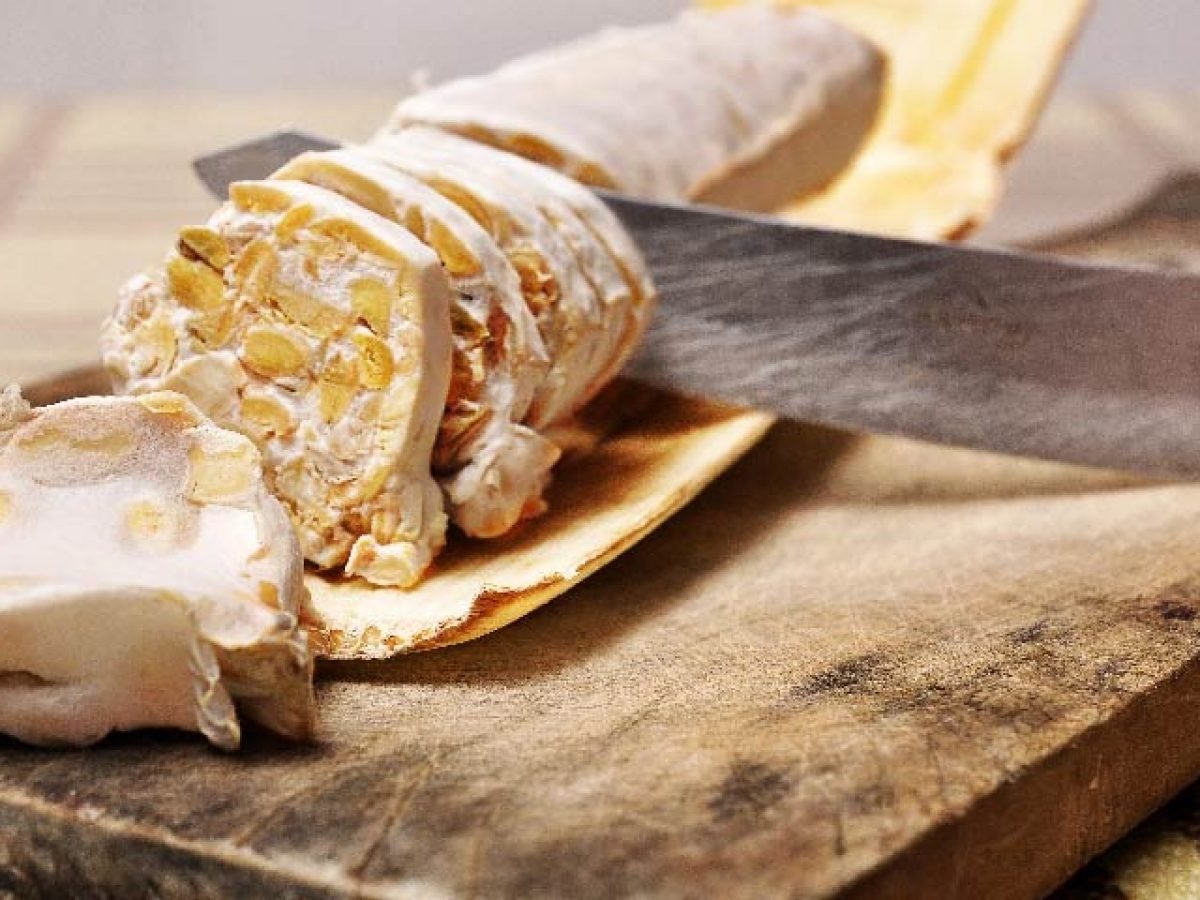The Americanized Tempeh: From Cultural Food to Health Fad
Image of Tempeh Being Sliced (CulturesForHealth)
By Nicolette Hendrawinata
Most Americans think of tempeh – the cake-like fermented soybean substance – as a meat substitute for the health-conscious upper-middle class. However, like most Indonesians living in Java, I think of tempeh more as a makanan rakyat: a staple food of the common people. Instead of sprinkling crispy tempeh as a topping for a salad, Javanese families are more likely to braise tempeh in coconut water, palm sugar, and spices (tempe bacem), and eat it with warm rice as a filling dinner. Instead of healthy air-fried tempeh chips, street vendors across Java are more likely to serve tempe mendoan – thinly sliced tempeh coated in a savory batter and deep-fried in hot oil. While tempeh’s transformation from a makanan rakyat into a westernized health fad can be traced to its early history in the United States, I believe that continuing to market tempeh away from its traditional origins may have some negative implications for the Indonesian-American community.
The Americanization of Tempeh
Tempeh was first introduced in the late 1950s to the United States through the work of Yap Bee Hwa, a Chinese-Indonesian researcher who brought dried tempeh inoculum to study at Cornell University. In 1961, Yap and her colleagues published the classic “Studies of Tempeh - an Indonesian Fermented Food” which focused on investigating the nutritional qualities of tempeh and its potential as a protein alternative for infants and children in developing countries. Yap’s research was soon followed by other studies, including a popular article by Dr. Hesseltine which proposed a new method of incubating tempeh in perforated plastic bags instead of the traditional banana leaf wrapper. By the early 1980s, articles about tempeh were widely distributed and discussed in American universities.
While researchers were exploring the possibility of tempeh as the main source of protein in developing Asian and African countries, businesses were more interested in commercializing it for general consumption in the United States. In the early and mid-1960s, Indonesian immigrants who were familiar with the traditional preparation of tempeh began setting up small production shops in California. However, these first-generation traditional shops quickly went out of business as tempeh found new life in an unexpected niche market: hippie populations with vegetarian or vegan diets. By the late 1970s, the majority of US tempeh producers are Caucasian-owned companies marketing to largely Caucasian hippie and alternative communities, with notable examples including Tempeh Works and Pacific Tempeh. This shift in producers and consumers, along with the development of modern tempeh-making in universities, is what caused the transformation of tempeh to the westernized health fad Americans are currently more familiar with.
Negative Implications for the Indonesian-American Community
I believe that tempeh’s recharacterization as a trendy health food for a largely Caucasian target audience has some negative implications for the Indonesian-American community. Marketing tempeh as a health fad may even be seen as an example of cultural appropriation: a situation where members of a dominant culture adopt parts of another culture in a way that takes it out of context or oversimplifies it. Like other instances of cultural appropriation, repurposing tempeh to fit American tastes without addressing its authentic origins shows disrespect towards the Indonesian-American identity while also taking away the community’s claim over their own traditional food.
Similar to other members of immigrant communities, many Indonesian-Americans consider cultural food as an important part of their identity. For instance, in Javanese culture, tempeh holds special meaning as a symbol of harmony and collaboration in families. Since the traditional way of making tempeh is a complex process that requires the whole family to participate, Javanese people believe that only harmonious families can create good-tasting tempeh. Considering this cultural context, making and eating tempeh together may be a meaningful way for Indonesian immigrant families to bond over their shared culture. Conversely, most American tempeh brands disregard Indonesian culture by ignoring this important symbolism in favor of marketing tempeh as a quick and easy meat substitute.
Additionally, the growing popularity of Americanized tempeh may make it hard for Indonesian-American businesses to sell more authentic versions of tempeh. Currently, not one of the largest 18 US tempeh companies was run by Indonesian-Americans. Furthermore, 95% of US tempeh was consumed by Caucasians. As tempeh’s image as a healthy meat substitute becomes crystallized in people’s minds, it would be hard for Indonesian-Americans to enter the market with traditional tempeh. Therefore, while Caucasian-Americans are able to monetize and generate profit off tempeh, Indonesian-Americans would likely not be able to create a livelihood from their own cultural food.
Conclusion
I initially attributed my aversion toward Americanized tempeh to my personal bias as an Indonesian. Compared to the flavorful traditional dishes I grew up with, the United States’s healthy and clean version of tempeh seems bland and unappetizing. However, after learning more about tempeh’s history in the United States, I realized that the Americanization of tempeh may actually have some negative implications for the identity and livelihood of Indonesian-Americans. Even though Americans are free to enjoy or cook tempeh, the current marketing of tempeh as a health fad is a potentially harmful practice that disregards Indonesian culture. In order to turn tempeh consumption from cultural appropriation into cultural appreciation, American producers have to learn how to integrate tempeh’s rich history and cultural context into their products.

